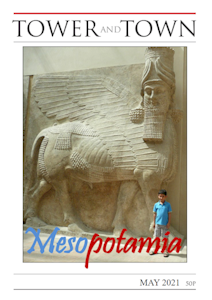

Tower and Town, May 2021 (view the full edition) (view the full edition)May BlossomsAs April progresses into May the bare outlines of the countryside persisting in early spring are finally dispatched as the hawthorn or may tree begins to blossom and cow parsley creates white-walled lanes. The sprays of white blackthorn blossom have already appeared a month before - the term 'blackthorn winter' referring to a spell of cold weather which sometimes coincides with their emergence in early April.  Once we see and smell the pink and white blossoms of the hawthorn along our hedgerows we know it is high spring. The flowers have an ambiguous perfume, musky and not entirely pleasant, and this combined with the aniseed-like scent from the luxuriating cow parsley can be intoxicating on a warm May morning. Cow parsley goes by various intriguing names: hedge parsley, Queen Anne's lace, fairy lace and mother-die. 50% of the world population of bluebells are to be found in the U.K. and to West Woods and other Wiltshire locations we make our annual pilgrimages. The tall beech trees, the heady scent of the flowers, the dappled sunlight falling on a sea of blue, it is all part of the magical experience on a May morning. Some of us boast of secret locations, but things vary from year to year. One small wood was always a special one for my wife and me, until, left untended, the wild garlic became rampant and almost choked out everything else. It is against the law to intentionally pick, uproot or destroy bluebells: a colony takes a long time to establish - around 5-7 years from seed to flower. The Spanish form is another threat to our native species. I begin to panic in mid-May as flowers disappear earlier than before and new ones sprout up before you can blink. Lady's smocks are already on the decline at the entrance to Savernake Forest and the beautiful snake's head fritillary is past its best on Cricklade's North Meadows, which houses the largest colony in the U.K. In special meadows managed by the Wiltshire Wildlife Trust the first orchids appear amongst the abundant cowslips: green-winged and early purple, with the promise of rarer species yet to come. On a sunny day there may be marsh fritillaries on the wing and high above a skylark filling the air with song. At such times Robert Browning's words still ring true:
The lark's on the wing, The snail's on the thorn; God's in His heaven - All's right with the world! Robin Nelson |